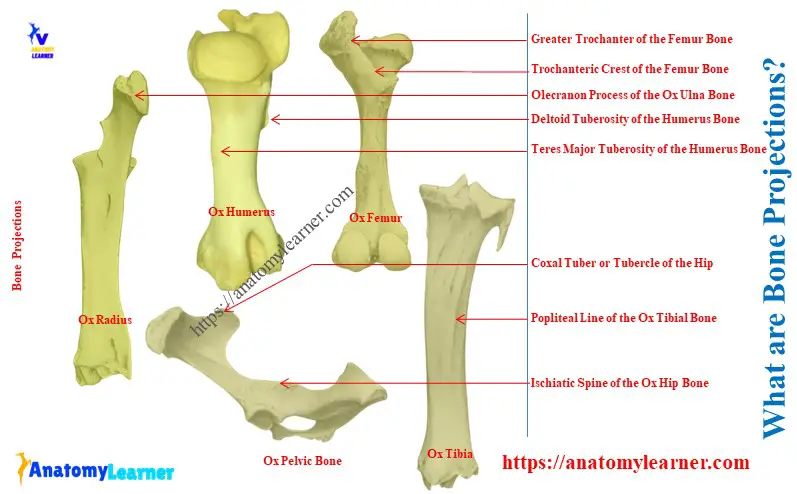The bones of the animal skeleton show long, large, elongated, and curved projections. Here, you will know the answer to the question – ‘what are bone projections’?
Quick answer and explanation: process, trochanter, cornu, tuberosity, tubercle, spine, crest, and line are the various types of bone projections.
I will describe all these bony projections with proper examples from animal bones. Thus, you will identify them from various skeleton bones while studying their osteological features.
What are the bone projections?
Explanation of the bone projections: Bones of the animal skeleton may possess various types of outgrowth. You may find longer or larger outgrowth of any bones. Again, it shows elongated bony outgrowth, which is different in appearance.

According to the nature of the outgrowth of the bone, it divides into the following –
- Large projection or outgrowth: process,
- Very large projection: trochanter,
- Elongated projection: spine, crest, and line,
- Small projection: tuberosity, tubercle, and
- Curved projection: cornu or hamulus,
So, process, trochanter, spine, crest, line, tuberosity, tubercles, and cornu are different types of bony projections. Table 1 shows the unique features of these bony projections with examples –
| What are bone projections | Features of the bony projections |
| Process | A large projection of the bones. Example: Olecranon process of ulna bone. |
| Trochanter | Very large projection of the bones. Example: Greater trochanter of femur bone. |
| Spine | Slender or pointed bony projection of the bones. Example: Spine of ox scapula bone. |
| Crest | Elongated and blunt bony projection. Example: Crest of the humerus bone. |
| Line | Faint, blunt, and elongated projection of the bones. Example: Gluteal line of the hip bone. |
| Tuberosity | Large, rounded, and rough projection of the bone. Example: Metacarpal tuberosity. |
| Tubercle | Small, smooth projection of the bones. Example: Facial tubercle of ox. |
| Cornu or hamulus | Curved projection of the bones. Example: Greater cornu of hyoid bone. |
What is a large projection on a bone called?
Answer: a large projection on a bone is called a process. However, there are a few differences between the bone process and the trochanter.
When the bone possesses a comparatively longer projection, it is the process of that bone. Again, when the projection is larger than other projections, it is the trochanter.
Here, the diagram shows the features from the proximal extremity of the ulna and femur bones. The ox ulna bone shows a longer projection on its proximal extremity, the olecranon process.
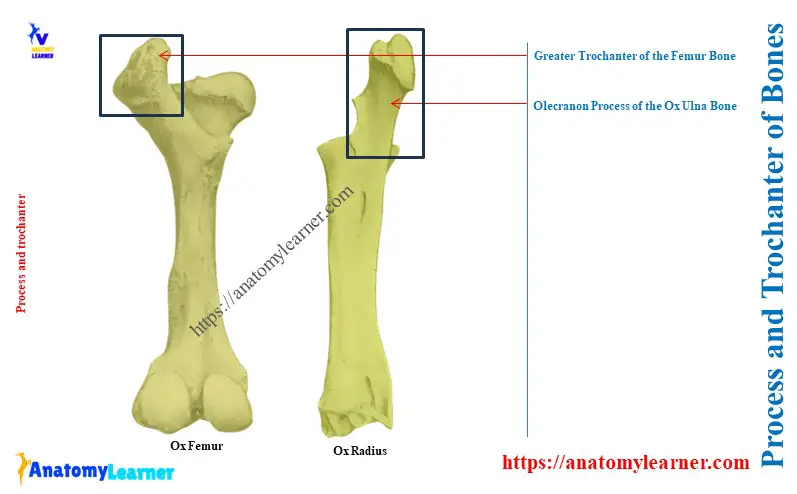
Again, the proximal extremity of the ox femur bone shows a larger bony projection. This projection is termed as the greater trochanter of the femur bone.
Suggested article for you: What is the difference between a facet and a process of the bones?
What are the elongated projections of the bone?
Answer: the spine, crest, and lines are the elongated projections of the bone. However, the nature of the elongated projections is different in the spine, crest, and line.
Here, the diagram shows the features from the lateral surface of the dog scapula bone. This lateral surface is divided by the elongated, slender, and sharp bony elevation called the spine.
Again, the cranial surface of the ox humerus bone shows an elongated bony elevation. This bony elevation is slender and sharp and termed as the crest of the ox humerus bone.
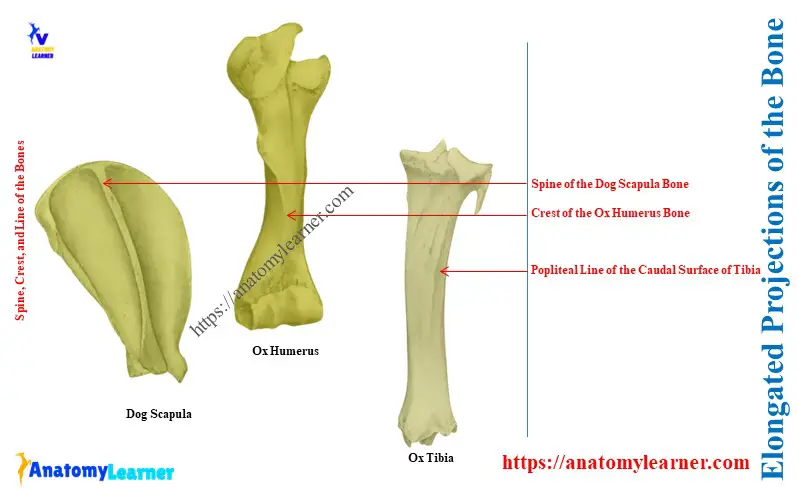
The caudal surface of the ox tibia bone shows different elongated bony elevations. These elevations are different than the appearance of the crest and spine. They gradually become faint and are termed as the line of the tibia bone.
What is a round projection of bone?
Answer: a round projection of the animal bone is the tuberosity. But, you might understand the difference between the tuberosity and tubercle of the bones.
The tuberosity of the bone is the large, rounded, and rough bony projection. Meanwhile, the tubercle is the large or small and smooth bony elevation of the specific bone.
The diagram shows the small, rounded, and rough projection on the dorsomedial aspect of the ox radius bone. This is the radial tuberosity of the ox radius bone. You will also find the lateral and medial tuberosities on the corresponding aspect of the ox radius.
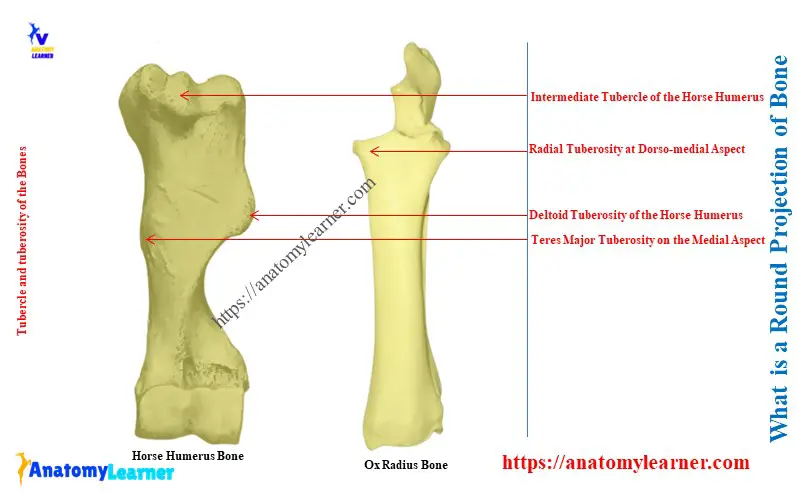
Now, let’s see the features of the cranial aspect of the proximal extremity of the horse humerus bone. The diagram identifies the intermediate tubercle between the lateral and medial tuberosities.
This intermediate tubercle of the horse humerus bone is a smooth bony elevation.
What is a curved projection of bone?
Answer: a curved projection of the bone is cornu or hamulus. Thus, the cornu or hamulus is the horn-like curved projection of the particular bone of animals.
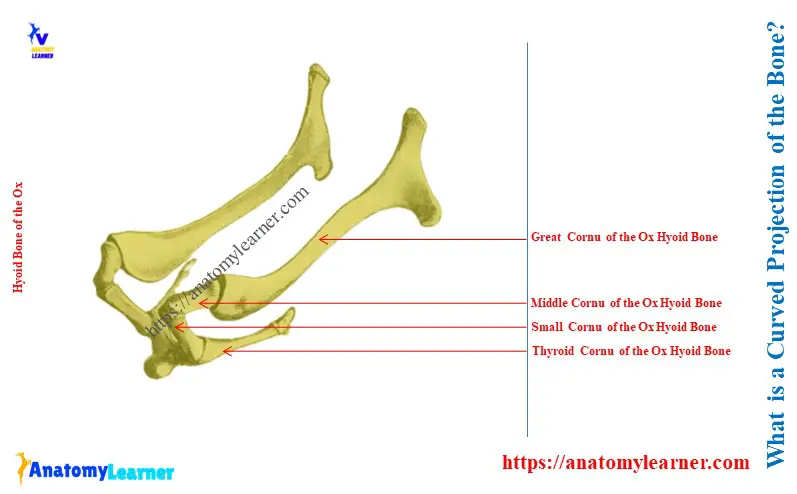
The hyoid bone of an ox or horse shows different small and large curved projections. These are the cornu or hamulus of the ox or horse hyoid bones.
Conclusion
So, the process, spine, tuberosity, and cornu are four significant types of bone projections. The appearance of these bony projections is also different in various bones of the animal skeletons.

